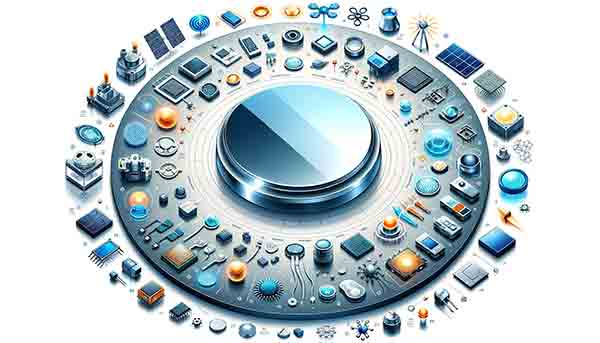What are Silicon Wafer Applications?
Question:
Where Do you Buy Silicon Wafers?
Answer: UniversityWafer, Inc. We have ever spec available. Simply provide your specs and quantity in the form below for an immediate quote.
Get Your Quote FAST! Or, Buy Online and Start Researching Today!
How are Silicon Wafers Manufactured?
Silicon wafers are fundamental components in semiconductor manufacturing, serving as the substrate for integrated circuits and various electronic devices. The manufacturing process involves several precise steps:
-
Purification of Silicon: The process begins with silica sand, which is refined to produce metallurgical-grade silicon. This silicon is then further purified to achieve the high purity required for semiconductor applications.
-
Crystal Growth: The purified silicon is melted in a crucible, and a seed crystal is introduced. Through the Czochralski process, a single-crystal silicon ingot is slowly drawn from the melt, ensuring uniform crystal orientation.
-
Ingot Slicing: The cylindrical silicon ingot is sliced into thin wafers using a diamond-coated saw. These wafers are typically 0.2 to 1.5 mm thick, depending on the application.
-
Wafer Polishing: The sliced wafers undergo chemical-mechanical polishing to achieve a smooth, mirror-like surface, essential for subsequent photolithography steps.
-
Cleaning: The polished wafers are meticulously cleaned to remove any contaminants, ensuring optimal performance in electronic devices.
What are Silicon Wafers?
Silicon wafers are thin, circular slices of crystalline silicon used as substrates in the manufacturing of semiconductors and electronic devices. Their primary role is to act as a base material for creating integrated circuits (ICs), microelectromechanical systems (MEMS), and photovoltaic cells.
These wafers are crafted through a meticulous process involving purification, crystal growth, and slicing of silicon ingots. Their purity level, surface quality, and crystal orientation are critical, as they directly affect the performance and reliability of the electronic components built on them. Silicon wafers come in various diameters, typically ranging from 100mm to 300mm, and can be either polished, etched, or coated, depending on the intended application.
Silicon wafers are essential in modern electronics, serving as the foundation for nearly all microchips used in smartphones, computers, and advanced technological devices.
What are Silicon Wafers Used For?
Just as a pivotal game can propel a team to the World Series, silicon wafers are key players in powering our electronic world. Here are some key applications:
-
Microelectronics and Integrated Circuits : Silicon wafers are the base material for most integrated circuits (ICs), including microprocessors, memory chips (RAM, ROM), and other types of microchips used in computers, smartphones, and a wide array of electronic devices.

-
Solar Cells : At the core of every solar panel, silicon wafers are crucial; they deftly convert beams of sunlight into usable electricity. Silicon wafers are the unsung heroes in solar panels, deftly converting sunlight into electric energy.
-
Sensors and Detectors : Silicon is used in various sensor technologies, including pressure sensors, temperature sensors, and light detectors. Silicon chips are the unsung heroes in our cars, hospitals, and factories—keeping tabs on everything from engine heat to patient temperatures.
-
Optoelectronics : Silicon wafers are used in optoelectronic devices that operate at the interface of electronics and light. Silicon wafers are key in crafting devices like LEDs, laser diodes, and photodetectors that bridge the gap between electronic signals and light.
-
MEMS (Micro-Electro-Mechanical Systems) : MEMS devices, which combine mechanical and electronic components on a microscopic scale, are often built on silicon wafers. In the palm of your hand, tiny tech marvels like accelerometers for tracking movement, gyroscopes for orientation, and microphones that catch every whisper are all powered by MEMS technology found in everyday gadgets.
-
Nano-technology : In the world of nanotech, just like a book inspires a movie, silicon wafers lay the foundation for creating incredibly tiny devices and intricate structures that push the boundaries of modern engineering.
-
High-frequency Radio Components : Silicon wafers are used in the production of RF (radio frequency) components, which are essential in wireless communication technologies.
-
Power Electronics : Silicon wafers are used in power electronics for devices like power transistors and thyristors, which are crucial in power conversion and control systems.
How well a silicon wafer works hinges on its purity, crystal makeup, and size—key details that tailor it to nail specific tech needs. Silicon wafers are getting cleaner, more orderly, and better sized for the jobs we throw at them. As our gadgets shrink but need to do more, these tiny tech slices keep pushing boundaries in all sorts of industries.
